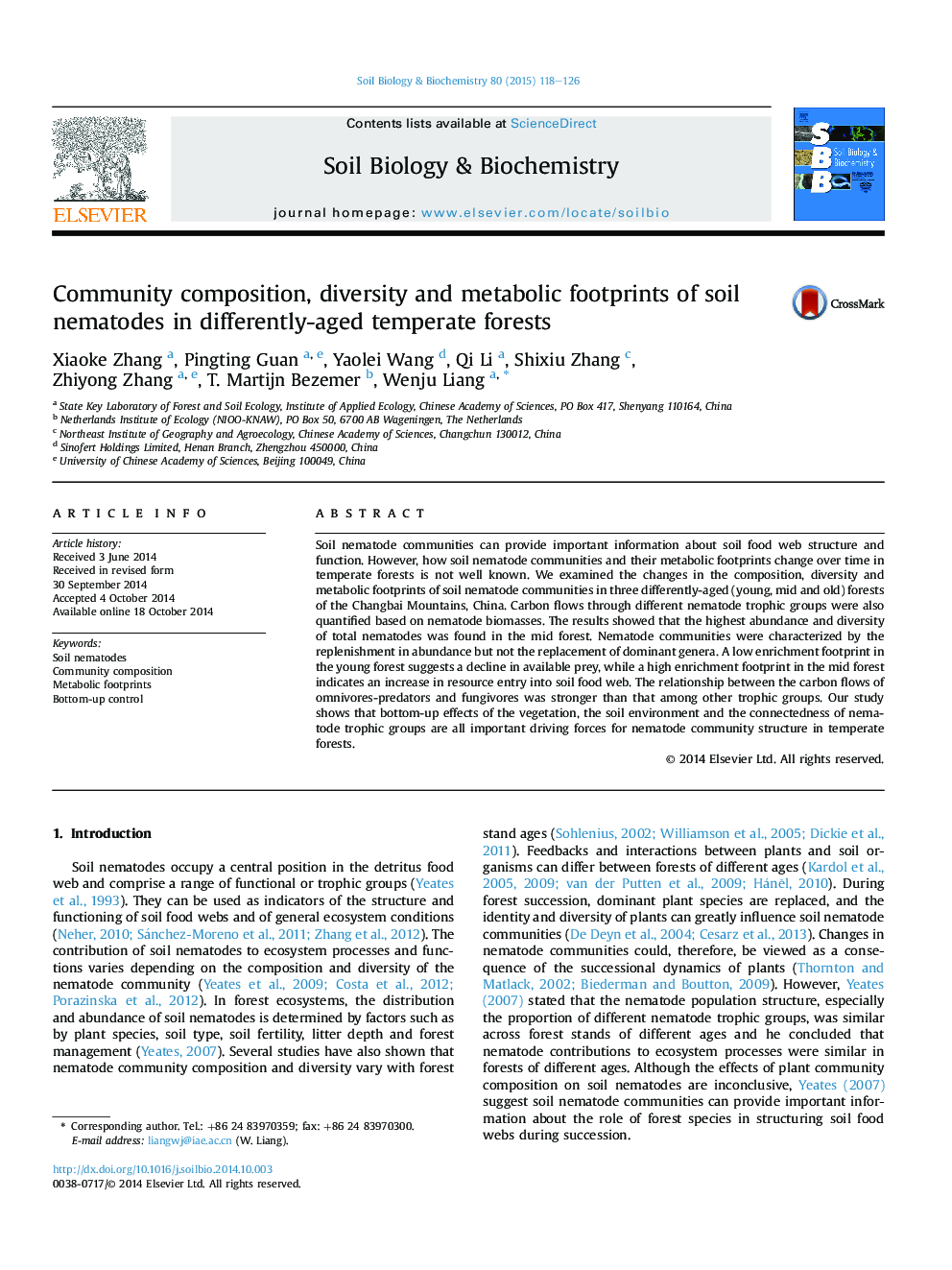| کد مقاله | کد نشریه | سال انتشار | مقاله انگلیسی | نسخه تمام متن |
|---|---|---|---|---|
| 8364388 | 1542604 | 2015 | 9 صفحه PDF | دانلود رایگان |
عنوان انگلیسی مقاله ISI
Community composition, diversity and metabolic footprints of soil nematodes in differently-aged temperate forests
ترجمه فارسی عنوان
ترکیب جامعه، تنوع و اثرات متابولیکی نماتودهای خاک در جنگل های معتدل مختلف
دانلود مقاله + سفارش ترجمه
دانلود مقاله ISI انگلیسی
رایگان برای ایرانیان
کلمات کلیدی
نماتدهای خاک، ترکیب جامعه، رد پای متابولیک، کنترل پایین،
ترجمه چکیده
جوامع نماتد خاک می توانند اطلاعات مهمی درباره ساختار و عملکرد وب غذای خاک ارائه دهند. با این حال، چگونه جوامع نماتودای خاک و اثرات متابولیک آنها در طول زمان در جنگل های معتدل تغییر می کنند، به خوبی شناخته نشده است. ما تغییرات در ترکیب، تنوع و اثرات متابولیکی جوامع نماتود خاک را در سه جنگل مختلف در (کوه های چانگبی، چین) در میان جنگل های جوان، متوسط و قدیمی مورد بررسی قرار دادیم. جریان کربن از طریق گروه های تروفیک مختلف نماتد نیز براساس بیوماس های نماتودهایی اندازه گیری می شود. نتایج نشان داد که بیشترین فراوانی و تنوع کل نماتدها در جنگل های میانی یافت شد. جوامع غیرمذهبی با فراوانی دوباره پرورش یافتند، اما نه جایگزینی جنینهای غالب. رد پای غنی سازی در جنگل جوان نشان می دهد کاهش شکار موجود است، در حالی که ریزش غنی سازی در جنگل میانه، افزایش ورود منابع به وب سایت مواد غذایی خاک را نشان می دهد. رابطه بین جریان کربنی علف هرز و شکارچیان و قارچ ها قوی تر از گروه های دیگر بود. تحقیقات ما نشان می دهد که اثرات پایین به بالا پوشش گیاهی، محیط خاک و همبستگی گروه های تروفیک نماتود، از مهمترین عوامل موثر در ساختار جامعه نماتود در جنگل های معتدل است.
موضوعات مرتبط
علوم زیستی و بیوفناوری
علوم کشاورزی و بیولوژیک
دانش خاک شناسی
چکیده انگلیسی
Soil nematode communities can provide important information about soil food web structure and function. However, how soil nematode communities and their metabolic footprints change over time in temperate forests is not well known. We examined the changes in the composition, diversity and metabolic footprints of soil nematode communities in three differently-aged (young, mid and old) forests of the Changbai Mountains, China. Carbon flows through different nematode trophic groups were also quantified based on nematode biomasses. The results showed that the highest abundance and diversity of total nematodes was found in the mid forest. Nematode communities were characterized by the replenishment in abundance but not the replacement of dominant genera. A low enrichment footprint in the young forest suggests a decline in available prey, while a high enrichment footprint in the mid forest indicates an increase in resource entry into soil food web. The relationship between the carbon flows of omnivores-predators and fungivores was stronger than that among other trophic groups. Our study shows that bottom-up effects of the vegetation, the soil environment and the connectedness of nematode trophic groups are all important driving forces for nematode community structure in temperate forests.
ناشر
Database: Elsevier - ScienceDirect (ساینس دایرکت)
Journal: Soil Biology and Biochemistry - Volume 80, January 2015, Pages 118-126
Journal: Soil Biology and Biochemistry - Volume 80, January 2015, Pages 118-126
نویسندگان
Xiaoke Zhang, Pingting Guan, Yaolei Wang, Qi Li, Shixiu Zhang, Zhiyong Zhang, T. Martijn Bezemer, Wenju Liang,
